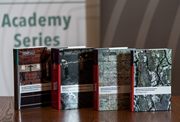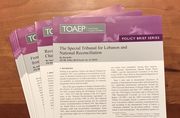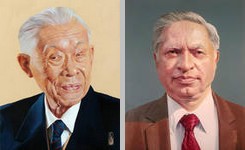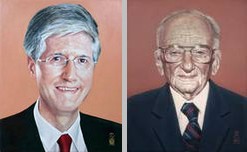Table of contents:
Element:
ICC:
In Lubanga, the Pre-Trial Chamber held:
"The Rome Statute prefers the terms 'conscripting' and 'enlisting' to 'recruitment'. In light of the foregoing, the Chamber holds the view that 'conscripting' and 'enlisting' are two forms of recruitment, 'conscripting' being forcible recruitment, while 'enlisting' pertains more to voluntary recruitment."[1]
Also, Lubanga Pre-Trial Chamber stated:
"the Chamber considers that the crime of enlisting and conscripting is an offence of a continuing nature - referred to by some courts as a 'continuous crime' and by others as a 'permanent crime'. The crime of enlisting or conscripting children under the age of fifteen years continues to be committed as long as the children remain in the armed groups or forces and consequently ceases to be committed when these children leave the groups or reach age fifteen."[2]
SCSL
The Fofana and Kondewa, the Appeals Chamber held that:
"the crime of enlisting children under the age of 15 years into armed forces or groups and of using them to participate actively in hostilities may be committed irrespective of the number of children enlisted by the accused person."[3]
Additionally, the Trial Chamber in Taylor held that there must be:
"a nexus between the conscription, enlistment and/or use and the armed conflict, that each of the victims was not taking an active part in the hostilities at the time of conscription, enlistment and/or use and that the perpetrators knew this fact."[4]
3.1. The perpetrator conscripted one or more persons into the national armed forces; OR
ICC:
"Lubanga Pre-Trial Chamber held that "conscripting is forcible recruitment"."[5]
Supporting the approach of SCSL Brima et al. Trial Chamber, the Trial Chamber in Lubanga stated that:
"[i]t follows that the status of a child under 15 who has been enlisted or conscripted is independent of any later period when he or she may have been "used" to participate actively in hostilities, particularly given the variety of tasks that he or she may subsequently be required to undertake. Although it may often be the case that the purpose behind conscription and enlistment is to use children in hostilities, this is not a requirement of the Rome Statute."[6]
Additionally, the Lubanga Pre-Trial Chamber stated that:
"[t]he crime of enlisting or conscripting "is an offence of a continuing character - referred to by some courts as a continuous crime and by others as a permanent crime". The crime of conscripting or enlisting children under the age of 15 continues to be committed as long as a child remains in the armed force or group and consequently ceases to be committed when the child leaves the armed group or reaches the age of 15 years."[7]
With regard to the term "national", the Lubanga Pre-Trial Chamber defined it as follows:
"the Chamber recalls that the context of international armed conflict is not restrcited solely to the use of force b/w two states, but that it extends to certain situations in which parties to the conflict may be organised armed forces or grps.[...] Firstly, the ordinary meaning of the adjective "national" does not necessarily lead to an interpretation of the term as meaning gover'tal armed forces. [...]Secondly, interpreting the term "national" to mean "govt'al" can only undermine the object and purpose of the Statute of the Court, which is none other than to ensure that "the most serious crimes of concern to the international community as a whole" must no longer go unpunished."[8]
"In fact, on the basis of basic humanitarian considerations and common sence, it would be absurd that Thomas Lubanga Dyilo could incur criminal responsibility for the crime of enlisting or conscripting children under the age of 15 yrs only in the context fo an internal armed conflict solely because the FPLC, as an armed force, could not be described as a "national armed force" within the meaning of article 8(2)(b)(xxvi) of the Statute. [...]thus, the chamber consdiers that, under art 8(2)(b)(xxvi) of the Statute, the term "the national armed forces" is nto limited to the armed forces of a State."[9]
SCSL
The Trial Chamber in Brima et al. held:
"'[c]onscription' encompasses any acts of coercion, such as abductions and forced recruitment of children by an armed group with the purpose of using them to participate actively in hostilities."[10]
Furthermore, according to the Trial Chamber in Sesay et al.,
"either the abduction of persons for specific use within an organisation or the forced military training of persons is independently sufficient to constitute conscription, as both practices amount to compelling a person to join an armed group. [...]Although not all the children abducted were eventually subjected to military training, the Chamber has found that the children who were not trained were used for other purposes within the RUF. We therefore find that notwithstanding their ultimate use, these abductees were compulsorily enlisted as members of the RUF or AFRC forces and therefore conscripted."[11]
3.2. The perpetrator enlisted one or more persons into the national armed forces; OR
ICC:
Pre-Trial Chamber in Lubanga held:
"'It follows therefore that enlisting is a 'voluntary' act, whilst conscripting is forcible recruitment. In other words, the child's consent is not a valid defence."[12]
Furthermore, according to the Trial Chamber in Lubanga,
"[i]t follows that the status of a child under 15 who has been enlisted or conscripted is independent of any later period when he or she may have been "used" to participate actively in hostilities, particularly given the variety of tasks that he or she may subsequently be required to undertake. Although it may often be the case that the purpose behind conscription and enlistment is to use children in hostilities, this is not a requirement of the Rome Statute. The Chamber therefore rejects the defence contention that "the act of enlistment consists in the integration of a person as a soldier, within the context of an armed conflict, for the purposes of participating actively in hostilities on behalf of the group."[13]
Lastly, the Lubanga Trial Chamber confirmed that:
"the consent of a child to his or her recruitment does not provide an accused with a valid defence."[14]
With regard to the term "national", the Lubanga Pre-Trial Chamber defined it as follows:
"the Chamber recalls that the context of international armed conflict is not restrcited solely to the use of force b/w two states, but that it extends to certain situations in which parties to the conflict may be organised armed forces or grps.[...] Firstly, the ordinary meaning of the adjective "national" does not necessarily lead to an interpretation of the term as meaning gover'tal armed forces. [...]Secondly, interpreting the term "national" to mean "govt'al" can only undermine the object and purpose of the Statute of the Court, which is none other than to ensure that "the most serious crimes of concern to the international community as a whole" must no longer go unpunished."[15]
"In fact, on the basis of basic humanitarian considerations and common sence, it would be absurd that Thomas Lubanga Dyilo could incur criminal responsibility for the crime of enlisting or conscripting children under the age of 15 yrs only in the context fo an internal armed conflict solely because the FPLC, as an armed force, could not be described as a "national armed force" within the meaning of article 8(2)(b)(xxvi) of the Statute. [...]thus, the chamber consdiers that, under art 8(2)(b)(xxvi) of the Statute, the term "the national armed forces" is nto limited to the armed forces of a State."[16]
SCSL
According to the Trial Chamber in Fofana and Kondewa:
"it is clear that voluntary enlistment is but one type of enlistment. The Chamber therefore fins that the term "enlistment" could encompass both voluntary enlistment and force enlistment into armed forces or groups, forced enlistment being the aggravated form of the crime. In the Chamber's opinion however, the distinction between the 2 categories is somewhat contrived. Attributing voluntary enlistment in the armed forces to a child under the age of 15 years, particularly in a conflict setting where human rights abuses are rife, is, in the Chamber's view, of questionable merit"."[17]
Moreover, the Taylor Trial Chamber held that:
" '[e]nlistment' entails accepting and enrolling individuals when they volunteer to join an armed force or group. Enlistment need not be a formal process, and may include "any conduct accepting the child as part of the [armed group]. Such conduct would include making him participate in combat operations". Conscription and enlistment are both types of recruitment, and while conscription involves an element of express compulsion or coercion, this element is absent in enlistment."[18]
"[t]he crime of enlisting or conscripting "is an offence of a continuing character - referred to by some courts as a continuous crime and by others as a permanent crime". The crime of conscripting or enlisting children under the age of 15 continues to be committed as long as a child remains in the armed force or group and consequently ceases to be committed when the child leaves the armed group or reaches the age of 15 years."[19]
The Appeals Chamber in Fofana and Kondewa noted that:
"[i]n the context of this case, in which the armed group is not a conventional military organisation, "enlistment" cannot narrowly be defined as a formal process. The Appeals Chamber regards "enlistment" in the broad sense as including any conduct accepting the child as a part of the militia. Such conduct would include making him participate in military operations."[20]
"a nexus must be established between the act of the Accused and the child joining the armed force or group in order to constitute enlistment. 'Whether such a nexus exists is a question of fact which must be determined on a case-by-case basis'."[21]
The Appeals Chamber in Fofana and Kondewa illustrated the scope of enlistment:
"on this occasion the initiates had taken the first step in becoming fighters. Consequently, the Trial Chamber found that when Kondewa was initiating the boys, he was also "performing an act analogous to enlisting them for active military service."[22]
3.3. The perpetrator used one or more persons to participate actively in hostilities.
ICC:
The Trial Chamber in Lubanga confirmed that:
"[t]he prohibition against using children under the age of 15 to participate actively in hostilities is not dependent on the individuals concerned having been earlier conscripted or enlisted into the relevant armed force or group. [...]Therefore, consistently with Article 22(2) of the Statute, a child can be "used" for the purposes of the Statute without evidence being provided as regards his or her earlier "conscription" or "enlistment" into the relevant armed force or group."[23]
The Trial Chamber in Lubanga held that:
"[t]he extent of the potential danger faced by a child soldier will often be unrelated to the precise nature of the role he or she is given.Those who participate actively in hostilities include a wide range of individuals, from those on the front line (who participate directly) through to the boys or girls who are involved in a myriad of roles that support the combatants. All of these activities, which cover either direct or indirect participation, have an underlying common feature: the child concerned is, at the very least, a potential target. The decisive factor, therefore, in deciding if an "indirect" role is to be treated as active participation in hostilities is whether the support provided by the child to the combatants exposed him or her to real danger as a potential target. In the judgment of the Chamber these combined factors - the child's support and this level of consequential risk - mean that although absent from the immediate scene of the hostilities, the individual was nonetheless actively involved in them. Given the different types of roles that may be performed by children used by armed groups, the Chamber's determination of whether a particular activity constitutes "active participation" can only be made on a case-by-case basis."[24]
"In this respect, the Chamber considers that this article does not apply if the activity in question is clearly unrelated to hostilities. Accordingly, this article does not apply to food deliveries to an airbase or the use of domestic staff in married officers' quarters."[25]
Furthermore, the Lubanga Trial Chamber stated that:
"an overly expansive definition of active participation in hostilities would be inappropriate as its consequence would be that children associated with armed groups lose their protected status as persons hors de combat under the law of armed conflict. Nonetheless, the Chamber finds that the nature and purpose of the crimes committed against civilians' warrants their characterization as active participation in hostilities. The Chamber considers this interpretation necessary to ensure that children are protected from any engagement in violent functions of the armed group that directly support its conflict against the adversary and in which the child combatant would be a legitimate military target for the opposing armed group or groups."[26]
SCSL
According to the Taylor Trial Chamber:
" '[u]sing' children to participate actively in the hostilities encompasses putting their lives directly at risk in combat, but may also include participation in activities linked to such carrying loads for the fighting faction, finding and/or acquiring food, ammunition or equipment, acting as decoys, carrying messages, making trails or finding routes, manning checkpoints or acting as human shields. Whether a child is actively participating in hostilities in such situations will be assessed on a case-by-case basis."[27]
In determining what activities constituted "active participation", the Trial Chamber in Sesay et al. focused on direct support and was:
"not satisfied that such conduct constitutes active participation in hostilities, as these activities were not related to the hostilities and did not directly support the military operations of the armed groups."[28]
Footnotes:
[1] ICC, Lubanga Confirmation Decision, 29 January 2007, para. 246.
[2] ICC, Lubanga Confirmation Decision, 29 January 2007, para. 248.
[3] SCSL, Fofana and Kondewa Appeals Judgment 28 May 2008, para. 125.
[4] SCSL, Taylor Trial Judgment 18 May 2012, para. 1606.
[5] ICC, Lubanga Confirmation Decision, 29 January 2007, para. 247.
[6] Lubanga Trial Judgment 14 March 2012, para. 609.
[7] SCSL, Taylor Trial Judgment 18 May 2012, para. 443 affirming ICC, Lubanga Confirmation Decision 29 January 2007, para. 248.
[8] ICC, Lubanga Confirmation Decision 29 January 2007, para, 275-281.
[9] ICC, Lubanga Confirmation Decision 29 January 2007, para, 284-285.
[10] SCSL, Taylor Trial Judgment 18 May 2012, para. 441; SCSL, Brima et al. Trial Judgment 20 June 2007, para. 734; similar language used in lubanga at 246-247.
[11] SCSL, Sesay et al. Trial Judgment 2 March 2009, para. 1695-1700.
[12] ICC, Lubanga Confirmation Decision 29 January 2007, para, 247.
[13] Lubanga Trial Judgment 14 March 2012, para. 609.
[14] Lubanga Trial Judgment 14 March 2012, para. 617.
[15] ICC, Lubanga Confirmation Decision 29 January 2007, para, 275-281.
[16] ICC, Lubanga Confirmation Decision 29 January 2007, para, 284-285.
[17] SCSL, Fofana and Kondewa Trial Judgment 2 August 2007, para. 192.
[18] SCSL, Taylor Trial Judgment 18 May 2012, para. 442 citing SCSL, Brima et al. Trial Judgment 20 June 2007, para. 734-735; SCSL, Fofana and Kondewa Trial Judgment 2 August 2007, para. 140, 144; and SCSL, Sesay et al. Trial Judgment 2 March 2009, para. 184; supported by the ICC, Lubanga Trial Judgment 14 March 2012, para. 607.
[19] SCSL, Taylor Trial Judgment 18 May 2012, para. 443 affirming ICC, Lubanga Confirmation Decision 29 January 2007, para. 248.
[20] SCSL, Fofana and Kondewa Appeals Chamber 28 May 2008, para. 144.
[21] SCSL, Sesay et al. Trial Judgment 2 March 2009, para. 191 citing SCSL, Fofana and Kondewa Appeals Chamber 28 May 2008, para. 141.
[22] SCSL, Fofana and Kondewa Appeals Chamber 28 May 2008, para. 970.
[23] Lubanga Trial Judgment 14 March 2012, para. 620.
[24] Lubanga Trial Judgment 14 March 2012, para. 628.
[25] ICC, Lubanga Confirmation Decision 29 January 2007, para, 262.
[26] SCSL, Sesay et al. Trial Judgment 2 March 2009, para. 1723.
[27] SCSL, Taylor Trial Judgment 18 May 2012, para. 444 citing SCSL, Brima et al. Trial Judgment 20 June 2007, para. 736-737. Sim lang ICC, Lubanga Confirmation Decision 29 January 2007, para. 261.
[28] SCSL, Sesay et al. Trial Judgment 2 March 2009, para. 1730.







